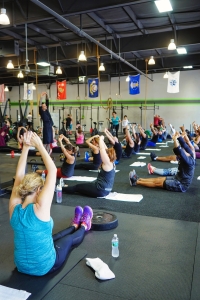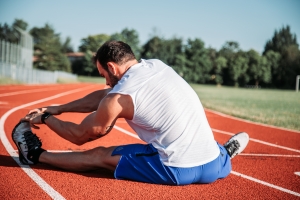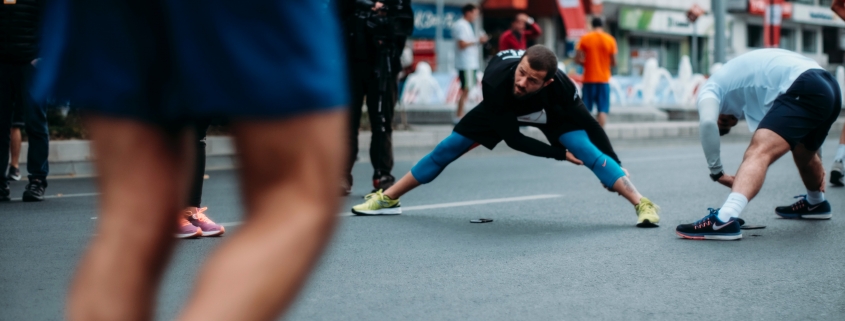The difference between Static & Dynamic Stretching. What to do and when
Everyone gets told that they should be stretching to keep their muscles healthy and prevent overuse injuries, but it is not always clear how you should be stretching or when it is best to do. The two main types of stretching you need to be aware of are static stretching and dynamic stretching. Static stretching does exactly what it says on tin, they are stretches performed without moving. Simply, you get into the stretch position you want, make sure you can feel the stretch in the desired location, and hold that stretch for a specific length of time. Holding the position for at least 20 seconds minimum is needed for muscles to relax and begin to lengthen. Dynamic stretches, however, a

re all about movement. Moving through a series of positions that take you close to end of range. The movements are slow and continuous and none of the positions are sustained. The aim with dynamic stretching is to gradually increase the range with each repeated movement. Static stretches are good for targeting specific muscles, are safe and simple to do, are easy to do at home, and can increase flexibility and range of movement. Dynamic stretches are good for mimicking the movement of the exercise you are about to perform (done in a warmup), can increase muscle performance, can target multiple muscles groups at once, and can improve body awareness.
The science bit:
When a muscle is stretched so are the little nerve endings within the muscle fibres. These nerve endings record the change in length of the muscle and how quickly it is happening. It then sends this information to the brain via the spinal cord. A stretch reflex is initially triggered, which attempts to resist the stretch in order to protect the muscle from tearing, and the muscle contracts slightly. The more sudden the change in muscle length, the stronger the muscle contraction will be (this is why you don’t “bounce” a stretch). If the stretch on the muscle is strong and/or sustained it can trigger a different set of nerve endings within the muscle’s tendon. These nerve endings record changes in muscle tension. When the tension exceeds a certain threshold, it triggers the lengthening reaction. This inhibits the muscle’s contraction and instead causes it to relax and lengthen, allowing it to stretch further.
So, when do we use each one?
Flexibility is a term used for how far a muscle will stretch. The total length of the muscle once stretched depends on how many of its fibres lengthen. Pliability is also important, as this is how willing your muscle fibres are to stretch. This is reliant on your nervous systems response to stretch. The more fibres willing to stretch the greater the overall length of the muscle. Both are essential to gain overall range and mobility. Some research into stretching suggests that if you do static stretching before a workout you might actually have a higher risk of injury than if you don’t. It has been shown that decreases in muscle power and speed might occur after a static stretching session, which is not ideal pre exercise. This has led to some people recommending that any stretching done before exercise should be dynamic. Dynamic stretching, however, has little impact on overuse injuries, where a lack of flexibility seems to be a causative factor. These overuse problems seem to relate strongly to long-term tissue changes that don’t necessarily respond to dynamic stretching. Some say that you get more benefit from static stretching if it is done just after a workout. This is based on the idea that your muscles are warm and well vascularised and therefore more likely to be pliable. It is also thought that post exercise your muscles are tired, allowing you to more easily take advantage of the lengthening reaction mentioned above. Several articles also suggest that stretching after activity can decrease post-workout soreness. Finally, a good workout will cause some micro-trauma to the muscles and the subsequent adaption, that makes you stronger, may occur with increased fibre length when you stretch after. This means that as you gain strength, stretching after a workout can allow you to prevent the associated loss of flexibility that occurs with muscle fibre growth.
Static stretching is more likely to help with flexibility and dynamic stretching with pliability. Many deem that an active warm up including dynamic stretching before a workout and a gradual cool down and some specific static stretching after are seen as the solution. If you are just looking to dedicate some time to increasing your mobility irrespective of pre/post workouts, then you could still use dynamic stretches to warm up and static stretches to gain range. This can be done at any time of day, but they are reliant on each other so are best done together.
An example Dynamic Warm up for Running
Total time: 8-10 min.
Step 1: Start with walking at your normal pace when you leave the house. Make sure you don’t forget to warm up your arms by letting them swing with every step. Exaggerate your arm movements and allow your torso to rotate slightly.
Step 2: After 2 minutes increase your pace but remain walking and swinging your arms up.
Step 3: After another 2 minutes pull your knee’s high up towards your chest with every step. Repeat at least 10 times on each leg.
Step 4: Repeat step 3 but this time, while your knee is by your chest, lift your foot up and forward. You should feel more of the stretch in your hamstring. Bring your foot down again and repeat with the other leg. Do at least 10 times either side.
Step 5: Continue walking quickly and now kick your heels backwards, trying to move them as close to your buttocks as possible. Again, repeat at least 10 times for each leg.
Step 6: Now try to walk on your heels for 10 meters. Do this by pulling your toes up as far as you can and walking with small steps. This is designed to stretch your calf muscles.
Step 7: For another 10 meters try to walk on your toes. Make small but quick steps.
Step 8: You should start to feel warmer by now. Now, do 10 walking lunges on each side. Make sure you keep your body nice and up right, your lunge is deep, and your front knee doesn’t move forward and past your ankle.
Step 9: Finally, start a slow run or jog for 1-2 minutes and repeat the above dynamic stretches (steps 3 to 7) during this easy run. You can then slowly increase to your normal running pace and enjoy your run!



